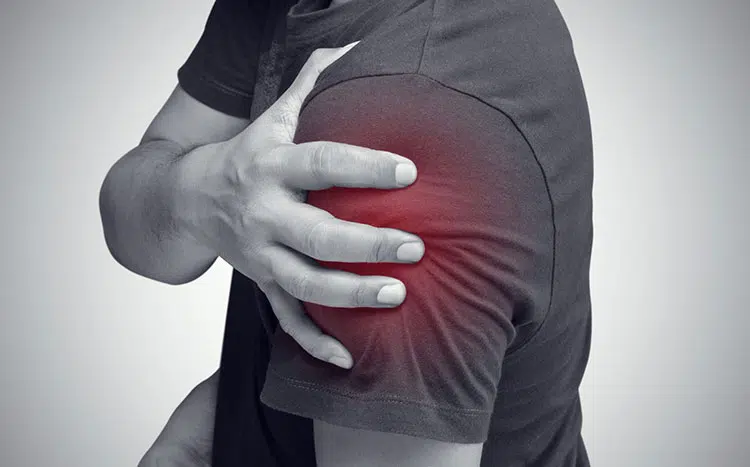Subacromial pain syndrome (SAPS) is a common cause of shoulder pain, particularly among individuals who engage in repetitive overhead activities or suffer from poor posture. SAPS refers to pain originating from the subacromial space, which is the area between the acromion (the top part of the shoulder blade) and the rotator cuff tendons. This condition is often associated with inflammation, irritation, or compression of the rotator cuff tendons or the bursa (a fluid-filled sac that reduces friction) within this space.
Understanding Subacromial Pain Syndrome
The shoulder is a highly mobile joint, allowing for a wide range of movements. However, this flexibility also makes it prone to injury and overuse. Subacromial pain syndrome is essentially a broad term used to describe several related shoulder conditions, including:
Rotator Cuff Tendinopathy: Inflammation or degeneration of the rotator cuff tendons.
Subacromial Bursitis: Inflammation of the bursa, which can cause pain when the arm is moved.
Shoulder Impingement: Compression of the rotator cuff tendons and bursa between the acromion and the humeral head (the top of the arm bone).
These conditions often occur together and result in similar symptoms, making SAPS a catch-all diagnosis for shoulder pain related to issues in the subacromial space.
Common Symptoms of SAPS
The primary symptoms of subacromial pain syndrome include:
Pain: Typically felt at the front or side of the shoulder, especially when lifting the arm overhead or reaching behind the back. The pain may also radiate down the arm.
Weakness: Affected individuals often experience weakness in the shoulder, particularly during activities that require lifting or rotating the arm.
Restricted Movement: The shoulder’s range of motion may become limited due to pain or stiffness.
Clicking or Popping Sensation: Some people may feel or hear a clicking or popping sound when moving the shoulder.
SAPS can develop gradually due to repetitive stress on the shoulder, poor posture, or muscle imbalances. It is also common in athletes who participate in sports that involve a lot of overhead movements, such as swimming, tennis, or baseball, as well as in individuals whose jobs require frequent lifting or reaching.
How Physiotherapy Can Help
Physiotherapy is one of the most effective treatments for subacromial pain syndrome. A well-structured physiotherapy program can alleviate pain, restore shoulder function, and prevent the condition from worsening. The treatment approach is typically tailored to the individual, addressing the underlying causes of SAPS and focusing on long-term recovery.
1. Pain Management
Pain relief is often the first step in treating SAPS. Physiotherapists use a variety of techniques to reduce pain and inflammation, allowing patients to move more comfortably and begin the rehabilitation process.
Ice and Heat Therapy: Ice can help reduce inflammation and numb the pain, especially after activities that aggravate the shoulder. Heat, on the other hand, can be used before exercises to relax the muscles and improve circulation.
Ultrasound Therapy: This treatment uses sound waves to promote tissue healing and reduce pain in the shoulder.
Electrotherapy: Techniques like TENS (Transcutaneous Electrical Nerve Stimulation) can help alleviate pain by interrupting pain signals sent to the brain.
2. Improving Range of Motion
Restoring the shoulder’s full range of motion is crucial for reducing stiffness and improving overall function. Physiotherapists guide patients through gentle stretching and mobilization exercises designed to increase flexibility and relieve tension in the shoulder joint.
Common exercises for improving shoulder mobility might include:
Pendulum Exercises: These involve gently swinging the arm in circles or back and forth, allowing gravity to assist in the movement and reduce pressure on the shoulder.
Cross-Body Arm Stretch: This stretch helps to alleviate tightness in the shoulder and improve flexibility.
Sleeper Stretch: This exercise is designed to improve internal rotation of the shoulder.
3. Strengthening Exercises
As pain subsides and mobility improves, strengthening exercises are introduced to help support the shoulder joint and prevent future episodes of SAPS. Strengthening the rotator cuff muscles and the muscles around the shoulder blade (scapula) is essential for maintaining shoulder stability and preventing impingement.
A physiotherapist will design a personalized strengthening program that progresses gradually in intensity. This program may include:
Resistance Band Exercises: These exercises target the rotator cuff and shoulder muscles, helping to build strength and stability.
Scapular Stabilization: Strengthening the muscles that control the shoulder blade is crucial for maintaining proper shoulder mechanics and preventing impingement.
Isometric Exercises: These involve contracting the muscles without moving the joint, which can be particularly useful when movement is painful.
4. Posture Correction and Ergonomic Advice
Poor posture, such as rounded shoulders or a forward head position, can contribute to SAPS by altering the position of the shoulder blade and reducing the subacromial space. Physiotherapists provide posture correction exercises and ergonomic advice to help patients maintain proper alignment during daily activities.
Some posture-improving strategies may include:
Shoulder Blade Squeezes: These exercises help to strengthen the muscles between the shoulder blades and improve posture.
Chest Stretches: Stretching the chest muscles can help counteract the effects of rounded shoulders.
Ergonomic Adjustments: Modifying your workspace, such as adjusting the height of your chair or desk, can reduce strain on the shoulders.
5. Manual Therapy
Manual therapy techniques, including joint mobilizations and soft tissue manipulation, can be highly effective in improving shoulder mobility, reducing pain, and relieving muscle tightness. These hands-on techniques are performed by a physiotherapist and are particularly beneficial in managing the mechanical aspects of SAPS.
Joint Mobilizations: Gentle movements applied to the shoulder joint to improve its range of motion and reduce stiffness.
Soft Tissue Manipulation: Techniques like massage can release muscle tension, improve blood circulation, and promote healing.
6. Education and Prevention
Education is a key component of physiotherapy for SAPS. Understanding the mechanics of the shoulder and the factors that contribute to subacromial pain empowers patients to take an active role in their recovery. Physiotherapists provide guidance on activity modification, proper exercise techniques, and lifestyle changes to prevent future episodes of SAPS.
Conclusion
Subacromial pain syndrome can be a painful and frustrating condition, but with the right approach, it is manageable and treatable. Physiotherapy offers a comprehensive treatment plan that addresses pain, restores shoulder function, and helps prevent recurrence. By working closely with a physiotherapist, you can regain your shoulder mobility, strengthen the surrounding muscles, and return to your daily activities without discomfort. If you’re experiencing shoulder pain or suspect you have SAPS, seeking early intervention with physiotherapy can make a significant difference in your recovery and long-term shoulder health.


